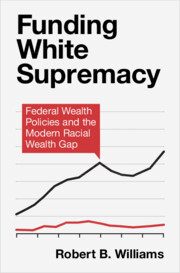Book contents
- Funding White Supremacy
- Cambridge Studies in Stratification Economics: Economics and Social Identity
- Funding White Supremacy
- Copyright page
- Reviews
- Contents
- Figures
- Tables
- Abbreviations
- Acknowledgments
- 1 Recognizing the Wealth–Race Nexus
- 2 Understanding How Households Get Ahead
- 3 Looking Back
- 4 Revealing Tax Expenditures
- 5 Inspecting the Leaky Bucket
- 6 Exploring Past Roots
- 7 Finding the Leaks
- 8 Assessing the Higher Education Ladder
- 9 Ending Malign Neglect
- Appendix
- References
- Index
1 - Recognizing the Wealth–Race Nexus
Published online by Cambridge University Press: 27 May 2025
- Funding White Supremacy
- Cambridge Studies in Stratification Economics: Economics and Social Identity
- Funding White Supremacy
- Copyright page
- Reviews
- Contents
- Figures
- Tables
- Abbreviations
- Acknowledgments
- 1 Recognizing the Wealth–Race Nexus
- 2 Understanding How Households Get Ahead
- 3 Looking Back
- 4 Revealing Tax Expenditures
- 5 Inspecting the Leaky Bucket
- 6 Exploring Past Roots
- 7 Finding the Leaks
- 8 Assessing the Higher Education Ladder
- 9 Ending Malign Neglect
- Appendix
- References
- Index
Summary
Sometime in 2021, the US economy became capable of making every American household a millionaire if wealth is spread equally. Of course, it is not. Indeed, it is one of the most unequally divided economies in the world. Whereas the typical Black household earns 60 percent of what Whites make, Blacks typically hold less than 10 percent of the wealth of Whites.
The tight link between wealth and race that is exhibited in the current racial wealth gap is simply the reflection of our nation’s history. From the earliest beginnings through constitutional protections of chattel slavery, disparate land policies, support of legalized segregation, and redlining, federal policies have created and cemented the link between wealth and race.
For many reasons, White Americans fail to acknowledge the yawning gulf that is the modern racial wealth gap. This failure along with the innate power that personal wealth brings creates a system that meets the requirements of Wilkerson’s caste system as well as offering a case study in stratification economics.
Keywords
Information
- Type
- Chapter
- Information
- Funding White SupremacyFederal Wealth Policies and the Modern Racial Wealth Gap, pp. 1 - 18Publisher: Cambridge University PressPrint publication year: 2025
